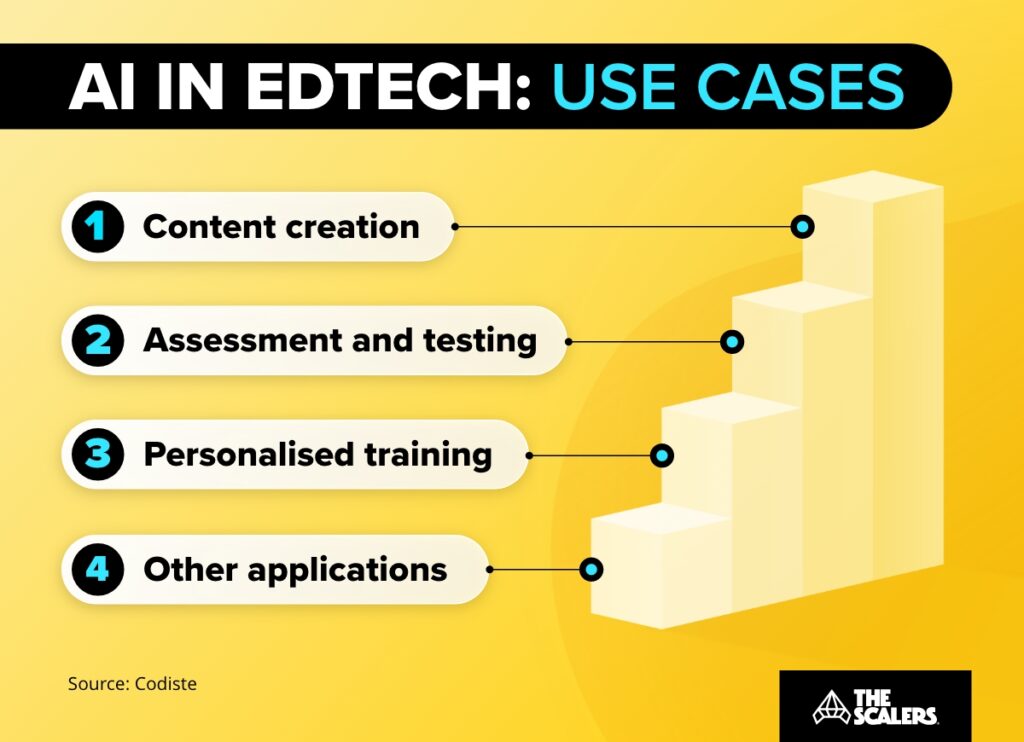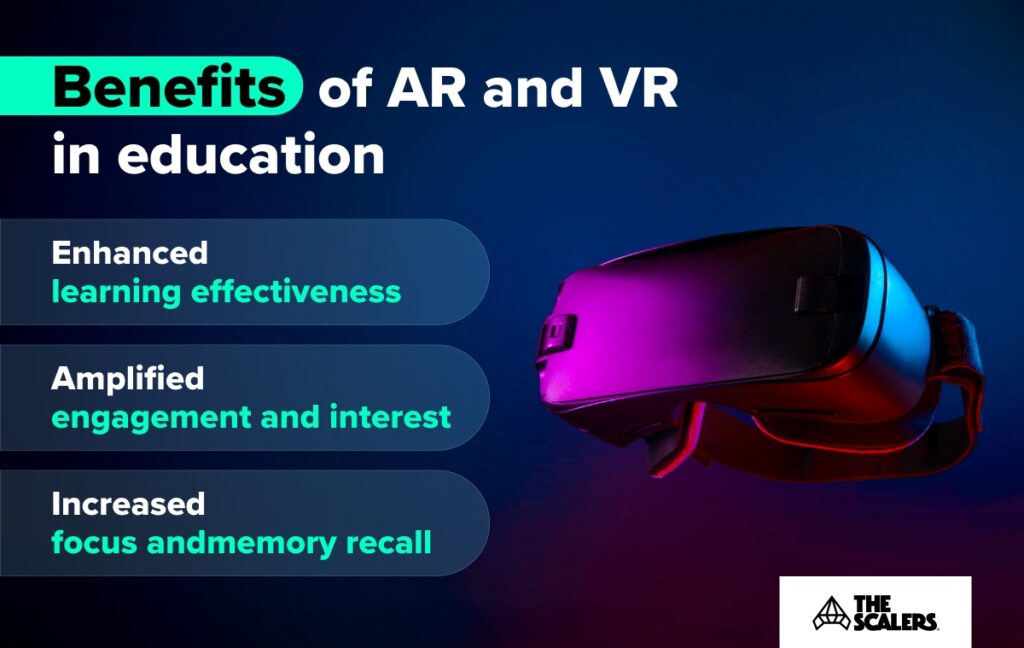Once reliant on chalkboards and textbooks, today’s classrooms are evolving into dynamic, tech-powered ecosystems. At the forefront of this transformation is educational technology (EdTech), a true driving force redefining how we teach, learn, train, and prepare for the future. With a projected annual growth rate of 13.4% between now and 2030, EdTech’s momentum is not slowing down.
The convergence of education and technology brings boundless possibilities but also complex challenges. Drawing from our experience setting up over 80 dedicated development teams – many in EdTech – we’ve created this guide exploring its foundations, impact, and trends shaping the future of learning, so you can stay informed and seize new opportunities in this dynamic industry.
Education Technology 101: Why EdTech is the future?
While the concept of EdTech has become almost synonymous with the COVID-19 pandemic, its roots stretch back decades, namely when projectors and digital whiteboards first made their appearance in classrooms around the world. Since then, EdTech’s scope has outgrown both its humble beginnings and our collective imagination. Through the use of cutting-edge technology such as AI, LMS, and cloud computing, the industry has single-handedly become the mainstay of modern education, leaving students, teachers, administrators, and whole institutions better off/transformed/irrevocably changed.

A good example of this comes from Finland, a nation long known for leading the charge in the arena of education. By integrating AI-powered virtual tutors — i.e. intelligent tutoring systems (ITS) — Finnish schools have moved away from rigid, standardised teaching methods to more personalised, adaptive and flexible learning pathways.
While this move is said to have improved student outcomes, specific data on its impact is limited until 2025, which is when Finland’s educational bodies plan to publish their findings. Nevertheless, Finland has set a clear benchmark for other nations looking to adopt this technology and fully leverage EdTech’s potential.
EdTech partnerships driving innovation
Building on Finland’s success, strategic partnerships between EdTech companies and educational institutions are undergoing a real boom. For instance, Microsoft has launched a scheme aimed to address poor future workforce readiness prognoses. Working alongside various educational institutions, it has rolled out a number of initiatives, each set to attack the wider issue in a different way, e.g. through specific tools, learning environments, and curricula.
The initiatives look as follows:
- Microsoft Learn for Educators – helping students acquire in-demand skills, e.g. AI, data science, cybersecurity
- Technology Education and Literacy in Schools (TEALS) – building sustainable programmes to inspire students to pursue technology careers
- AI and cloud computing integration – collaborating with institutions to incorporate AI and cloud technologies into learning environments
- Technical Skills Gap response – aligning technical skills programmes with academic offerings to bridge the gap across fields like AI, computer science, and cybersecurity
AI is transforming the education industry, changing how administrators, educators, and students operate. Now, more than ever, it’s important for everyone to stay informed about the opportunities and challenges presented by this innovative technology.
Similarly, 2U, Inc., a key player in the EdTech space, has partnered with many nonprofit colleges and universities to expand access to quality education through digital platforms. Working alongside the London School of Economics, 2U developed online degree programmes designed to align academic learning with industry requirements; an equally contentious issue seen leaving employers in a tight spot over the years.
At a time when graduates are entering the workforce lacking essential skills, as underscored by the OECD’s research findings, these collaborations are a critical intervention. Of course, it’s not just the curricula struggling to keep pace; many of the same institutions we’ve always looked to for guidance are also grappling with the need to adapt. In consequence, official responses to the uncertain future we’re facing against a backdrop of skills shortages and scarce workforce readiness, follow a similar pattern.
Future of education technology trends 2025
As EdTech continues to evolve to meet the changing needs of today’s learners, some of its innovations are cutting through the noise. From personalised learning powered by artificial intelligence to immersive experiences enabled by AR and VR, the following trends are paving the way for more engaging, inclusive and future-proof learning. Let’s dive into the trends shaping the future of education in 2025 and beyond.
Artificial intelligence
Once the stuff of speculative conversations and science fiction fantasies, artificial intelligence (AI) has fast emerged as a transformative force, bringing classrooms worldwide up to speed with the needs of today’s learners.
No longer confined to automating repetitive tasks or putting plagiarism checkers out of business, AI has evolved into a personalised mentor capable of delivering customised, adaptive learning experiences. Platforms like Knewton’s Alta are a prime example of these capabilities; tracking progress and adapting lessons in real time based on each student’s unique needs. As a result, students receive the support they need to fully engage with the learning process, whether that includes revisiting basic maths, or moving onto more challenging material.

At the same time, the rise of adult learning platforms like Coursera and LinkedIn Learning points to AI’s significance beyond the school gates. Through the means of automated progress tracking, adaptive content delivery, and automated assessments, lifelong learning can finally become a legitimate pursuit, capable of helping learners stay competitive in a fast-changing world.
VR & AR
Though immersive reality tools the likes of VR and AR initially fell victim to bad PR, they’re seeing a massive resurgence thanks to EdTech. Having shed their status as a gaming gimmick, they are now reshaping how knowledge is delivered, retained, and applied, particularly in fields where hands-on practice is fundamental.
Tools such as Google Expeditions and zSpace have sprung out of this trend, offering virtual field trips and giving STEM students much-needed exposure to complex concepts in totally risk-free environments. Of course, beyond bridging the gap between theory and real-world application, the technology is enabling learners to experience education rather than simply consume it, as futurist Bernard Marr puts it, emphasising its potential to create engaging, experiential learning/education.

This applies to adult learners, too, with platforms like Strivir increasingly addressing use cases beyond the classroom. Simulating scenarios ranging from public speaking, conflict resolution, to inspecting a historic landmark from the other side of the globe, immersive technology lends itself to all types of needs, goals, and interests. Though previously unheard of in education, this type of flexibility and adaptability are precisely how we future-proof our careers in an ever-evolving world.
For businesses, these tools aren’t just about skill development — they also improve employee engagement and satisfaction. Immersive learning feels less like “training” and more like exploration, appealing to workers across generations. Research from Deloitte highlights that 47% of businesses are already experimenting with AR/VR in employee training programs, demonstrating how immersive technologies are gaining traction, not just as a novelty but as a competitive edge in education and business alike.
Gamification
Similarly to immersive tech, gamification is another innovation that EdTech has co-opted with resounding success. Still, you may remember when gamification first became a thing, it probably felt quite primitive despite Duolingo’s success, rewards, leaderboards, and pixelated badges hardly screamed avant garde.
In recent years, accelerated by EdTech, gamification has evolved into a sophisticated tool, capable of amplifying all manner of behaviours, from engagement, motivation, and collaboration, to overall learning outcomes.
For business and tech leaders, gamification offers a blueprint for transforming corporate training and upskilling initiatives, but also things such as onboarding, and team collaboration. Should you be a bit sceptical about such claims, you’ll be surprised to learn that even companies like Cisco have incorporated game-like mechanics into their cybersecurity training, turning what might otherwise be dry content into an engaging and competitive experience. Likewise, SAP’s Roadwarrior, an app featuring a number of simulated client-facing scenarios, resulted in 55% voluntary participation and an overall higher team performance.
Overall, with its growing investment and diverse range of applications, gamification has the potential to go beyond its status as a trend and continue to shape the future of education technology. The key lies in its evolution from the same set of simplistic mechanics to more adaptive and immersive experiences.
Micro-credentials and lifelong learning
To some, lifelong learning means a fortnightly pottery class they do at the local library; to others it’s the SEO Manager they’ve had on their work to-do list since 2021. Still, as Bernard Marr tells his readers, lifelong learning is about to get a makeover as accelerating digital transformation calls for a radically different approach to education.
To put this in perspective, consider that 65% of today’s primary school students are expected to work in jobs that don’t exist yet (World Economic Forum, 2016). Against this backdrop, our traditional education with its lengthy, rigid degree programmes and the idea of education as a one-and-done deal versus a lifelong pursuit, appears to fall short.
Meanwhile, lifelong learning has also come to mean things such as modular, bite-sized, flexible learning. This type of learning is exemplified by Amazon’s degree-level apprenticeship programmes, combining modular courses with on-the-job training. Original though it may seem, Amazon’s move towards modular learning reflects a wider trend, gaining traction with EdTech’s help, which shows employers increasingly prioritise skills-based credentials faced with pressure to satisfy evolving business needs and priorities.
Modular and lifelong learning are now all about preparing for the uncertain future we’re on the verge of. As industries change in ways yet unforeseen, this type of flexible, pay-as-you-go education is precisely how we future-proof our careers and workforce.
Platforms like LinkedIn Learning and Coursera have anticipated this education technology trend, having offered online courses as micro-credentials since before online learning became a legitimate pursuit rather than an extension of Millennials’ Internet addiction.
The future of education technology is likely to feature modular and lifelong learning quite heavily, meanwhile, the concept of modularity could combine with AI-driven “learning playlists” — personalised recommendations guiding us through the micro-courses needed to accomplish our goals amid an uncertain future.
Challenges facing EdTech
As nearly half the global population still grapples with a lack of a reliable internet connection, a trend disproportionately affecting rural and low-income communities — questions of access continue to cast a shadow over the future of education technology. Similarly, many platforms still fail to provide necessary accommodations for learners with disabilities, such as adaptive interfaces and screen readers.
Meanwhile, the move to online courses and personalised learning experiences has also brought to the forefront questions regarding privacy and security. With the massive amounts of data collected by EdTech platforms, the risks of data breaches and cybercrime also skyrocket — a trend that’s projected to top $10.5 trillion per year by 2025 (Cybersecurity Ventures, 2023).
Lastly, a lack of uniform implementation practices among educators is also seen as hampering the EdTech revolution. A 2023 UNESCO survey showed that 63% of teachers lack the training needed to incorporate digital tools effectively, ultimately leaving them frustrated and overburdened — a fact that does little to further the EdTech’s cause.
Overcoming these hurdles will require collaborative efforts between governments, tech companies, and educational leaders. Though significant, the barriers are not insurmountable, particularly viewed through the lens of EdTech’s many benefits.
EdTech is no longer a supporting player — it’s the main act in the education revolution. By breaking barriers, personalising learning, and championing lifelong education, it holds the key to a future where knowledge is a universal right. The challenge for leaders today is to ensure that the future is not just technologically advanced but inclusive, secure, and equitable.
The need for more engineers in EdTech
As EdTech continues to reshape the future of education, the demand for skilled engineers has never been greater. Bringing to life advancements such as adaptive learning algorithms and immersive platforms, requires a robust engineering workforce capable of developing, maintaining and scaling these solutions.
Meanwhile, many companies face a talent shortage, with their existing rotas of qualified professionals struggling to keep up with the industry’s rapid growth.
Offshore dev teams are a practical solution to this challenge. By leveraging global talent pools, EdTech innovators can accelerate their growth, shorten their time to market, and play a leading role in shaping the future of education.
At The Scalers, we help EdTech companies set up cost-effective offshore teams in Bangalore, India using our best offshore model.
Instead of allocating resources from a bench, we hire engineers to your exact job descriptions. They work as part of your company, using your tools and systems, but we handle all the headaches on the ground. To ensure they are productive, happy, and stay around for the long term, each team gets a dedicated Chief Happiness Officer who builds a world-class culture you can be proud of.
All this means you can bring new innovations to market faster.
Key takeaways
-
1
The education system is evolving rapidly, fueled by the integration of new technologies like AI, AR, and cloud computing, transforming classrooms into dynamic, tech-driven ecosystems.
-
2
Lifelong learning and modular education are becoming essential as industries evolve. Flexible, skills-based micro-credentials are replacing traditional degree programs, with platforms like LinkedIn Learning and Coursera leading the way.
-
3
Strategic collaborations between EdTech companies and educational institutions are addressing gaps in workforce readiness and skills alignment.
-
4
EdTech comes with various challenges, namely to do with accessibility, privacy, and teacher buy-in
-
5
EdTech’s continued expansion will require a concerted effort between tech companies, educational institutions, and policymakers, in order to ensure its risks do not outweigh its benefits.
The future of education technology is global, agile, and competitive. To stay ahead, you need more than good ideas – you need scalability, cost-efficiency, and access to the right talent. Don’t let operational challenges get in the way – get in touch and let our offshoring experts show you how offshoring can power your innovation and accelerate your growth.
Build Your Team,
Not Just a Contract
With The Scalers’ offshore dedicated development team, you get engineers who join your workflow for the long run. Grow steadily, stay flexible, and work with people who care about the product as much as you do.








